Dov Charney was terminated by American Apparel last week. I see quite a few articles calling him a “sleezebag” and lots of folks really seem to enjoy seeing him fall. There are quite a few inaccuracies in the reporting, and most people don’t know the man. One article says he was partly fired for using company funds to pay for a plane ticket for his parents. Really? He shouldn’t have done that, but that seems pretty minor compared to the crazy over the top multi-million dollar shenanigans pulled by Bill Farley at Fruit of the Loom for just one example. He did live large and craved the spotlight and so some of this he absolutely brought upon himself.
Dov has a big mouth and very little editing of the path between his brain and mouth and I’m sure it got him in trouble again. Add to that the financial problems of American Apparel and it is no surprise he didn’t last. (Although you have to see that just about every company in this industry has had at some point had financial problems, for example Alphabroder, Fruit, MHM, M & R, and on and on.)
Sorry, but I’m not kicking the guy when he is down. He revolutionized fashion, revolutionized the t-shirt, and he made probably the biggest anti-sweatshop effort we have seen in our lifetimes. His factory with thousands of employees treated well is a shining example of what can be done within the realm of ethically manufacturing. I wish him well.
Here are a couple pieces that the Ink Kitchen did on Dov and I still stand by them.
[divider type=”black|thin|thick|short|dotted|dashed” spacing=”10″]
A Visit to American Apparel
Feb 12, 2014
The Ink Kitchen aims for the quick jab, a paragraph and a photo and back to your day. Occasionally a subject will deserve a longer form. A day long visit to American Apparel is such a topic. From time to time you’ll see these longer pieces, probably about once a month.
You also are going to see that I have a pretty positive attitude toward American Apparel. Anyone that knows me will have heard these opinions come out of my mouth regularly for as long as I can remember. With The Ink Kitchen Tom and I want no part of the myth of journalistic objectivity. All writers come to a story with their biases, the best you can do is reveal them, not hide them.
We are not positive about companies because they are sponsors, instead the converse, we are only asking companies we are already using in our day-to-day work to be sponsors of The Ink Kitchen. Our allegiances are born of years of working with them day to day in our decorating businesses, not any kind of cheap cash transaction.
American Apparel 2014
Bullshirt. Bullshirt is my word for phony-ass marketing ploys for Made in USA or anti-sweatshop adverts that are high on hype and low on delivery. American Apparel on the other hand, in my estimation, is the real deal. Big factory, big ideals, … well and a CEO with a big mouth. They have literally thousands of full-time workers treated well and they make everything right in Downtown LA. Here’s a quick look through their mammoth, seven-story beehive of a factory:
American Apparel has had an impact the past twenty years on the t-shirt market like nothing we have seen since the Champion sweatshirt came on the scene in the thirties or since Marlon Brando wore a white t-shirt in “A Streetcar Named Desire.” 30 Singles Ringspun Cotton T’s are now part of the the norm not an aberration. If not the first to make such shirts, American Apparel certainly was the first to popularize them.
Driving up to American Apparel in Downtown Los Angeles, one of the first things you notice are the enormous signs at the top of the seven-story buildings that say, “Immigration Reform Now“ and “Legalize LA.” You know you are not at your average garment factory. There is not another business in the garment industry or perhaps any industry of this magnitude that takes such an active role in promoting immigration reform.
I know Dov Charney and several other managers and employees past and present of American Apparel from the days when I was the CEO in a last gasp attempt to save a factory in Los Angeles. The factory was the then-sinking ship called sweatX, a worker-owned unionized garment factory. sweatX started with capital and noble ideals from Ben Cohen of Ben and Jerry’s ice cream fame. The ideals were righteous, the idea was great, the execution was poor and ultimately the factory had to close its doors. As The Nation quoted me saying at the time, “The candy store failed because it was run poorly…not because customers don’t like candy.” sweatX proved you could make shirts without exploitation and proved absolutely that there was a market for righteously produced shirts. Unfortunately in the case of sweatX, bringing such shirts to market was done very poorly. I was given the task of trying a last minute turn-around and I was in Downtown LA amongst legions of homeless folks and the poor workers in the neighborhood, right near the American Apparel factory. I had met Dov at various anti-sweatshop events and at trade shows. Marty I met working on Farm Aid. When suddenly I was their neighbor and not 3000 miles away, we got some time to hang out (when we weren’t working 12 hour days.)
Many folks believe in a world where clothing can be produced without the subjugation of the work force. I am one of those people. I believe that American Apparel CEO Dov Charney and CMO Marty Bailey are fellow travelers on that road. We all have very different styles, but we aim for the same outcome: a world where workers make a living wage and are treated with respect.
The most false thing I hear from people when I mention American Apparel is that CEO Dov Charney has been convicted of sexual harassment multiple times. He has indeed been accused, but nobody has won any lawsuits nor have there even been any settled lawsuits. Here is a link to an article in Business Insider about that.
Another issue is that folks feel that American Apparel adverts are exploitive of women and they use sex to sell American Apparel clothing. American Apparel is trying to sell lots of clothing that is sexy. One of my daughters said, “Their target demographic is young men and women. This makes sense. LL Bean makes ads where women look comfortable. AA could make those ads too, but it would be ridiculous to insinuate that gold spandex leggings are comfortable, or that they will be worn by your grandmother.” It seems to me, that sexy clothing would be difficult to sell with puritanical advertisements. I personally have a problem with the adverts with what look like underage women (though they are not) and have told Dov so. However, I have not really heard other people make that distinction. It seems always to be a general complaint about using sexual imagery to sell. Even if you don’t like that, you have to give them credit on some aspects of their marketing. They rarely use professional models and they have often used very untraditional looking people to show off their garments, including a recent lingerie campaign using a 62 year-old model.
The argument I hear from some folks on the Left Wing side of the dial is that American Apparel is “anti-union.” I actually arrived in LA to work on sweatX the day after there was a rally outside the American Apparel factory to kick off a unionizing effort there. Some mistakes were made by both sides, both sides agreed in court about that, and then ultimately there was no union formed at American Apparel. Personally I am very pro Union. My print shop Mirror Image has been a union shop (UAW Local 1596) since twenty-five years ago when I had two employees and encouraged them to seek out a union. I feel that despite the many problems with unions that most of the gains of workers in the past 100 years have come through unions. Imperfect as they may be, they should be part of any gold standard on certification that a factory is not a sweatshop, for only with the protection of a union contract can workers speak up about conditions at the factory. Workers are always going to see so much more than any type of monitoring can ever see.
Why American Apparel was chosen for a union drive I will never understand. Tactically it is insane as you target some of the best paid and best treated workers in the US garment industry and it was a fight the union was not going to win. You can literally walk two minutes from American Apparel and see a real sweatshop in operation. There are thousands of workers toiling in substandard if not deplorable conditions. Why not target these companies? I was present while the union drive happened at American Apparel, anti-union sentiments among the workers I can tell you was high, and the union drive failed.
Dov Charney is one of those people we all know and some of us are mostly entertained by, who have zero editing between their brain and their mouth. Dov, I believe, takes it one step further and actually has an accelerator between his brain and his mouth. It makes him a great spokesperson at times. It makes him highly entertaining and amusing to be around, and it sometimes gets him into trouble and certainly makes him an easy target. I heard an interview with Dov on NPR’s Marketplace while I was in the middle of writing up this post. He said, ““My biggest weakness is me. I mean, lock me up already! It’s obvious! Put me in a cage, I’ll be fine. I’m my own worst enemy. But what can you do—I was born strange.”
In some ways he is irrelevant to this whole story and in some ways essential. I have had people in his marketing department in the past tell me that the anti-sweatshop message of American Apparel is not effective in selling more garments, but Dov insists on it anyway. Kudos to him as he, more than any other person in the world that I know of, has made “sweatshops” an issue. And what I found in my most recent visit is what I have found in every visit there, that the anti-sweatshop work of American Apparel is absolutely ingrained in their culture and systems and in everything they are trying to do. It isn’t some bullshirt marketing ploy; it is in the DNA of the company. I won’t mention them by name but there are a host of other companies that make their “anti-sweatshop” claims purely as marketing , knocking off the style and message of the American Apparel advertisements in a facile way just the way so many have knocked off (not sure why its not called stealing like it would be in other industries) the styles of the American Apparel garments.
You have on one hand a big mouthed CEO and to some folks, what are objectionable adverts. On the other hand you have over 5000 employees including 2700 people sewing for a company that is pushing for their good treatment, as well as extremely publicly advocating for immigration reform and anti-sweatshop manufacturing.
Any new product line at American Apparel is done with vertical integration as the ultimate goal. They may subcontract out the manufacture of the bottoms of their sneakers or the wooden heels of their shoes, but rather than as a way to cut costs, it is always only a first step in eventually bringing it under their roof for American Apparel workers to do the work. They still subcontract the sneaker bottoms, but this trip I saw piles of lumber and a new shop within the factory making wooden heels.
Ask anyone in the Fair Trade or anti-sweatshop movement and they will tell you that subcontracting is a serious problem with any type of certification of a company being Fair Trade. It is difficult enough to monitor (I would say almost impossible) what goes on in a factory, but there is no way that you can root out all abuses if the work goes elsewhere, often in a sort of shell game of “hide the abuse.” This effort at American Apparel to control all the production is a definite step in the right direction.
It all happens primarily in one big building. Even the management and white collar folks come in the same way as the production workers. They walk the same halls and ride the same big freight elevator.
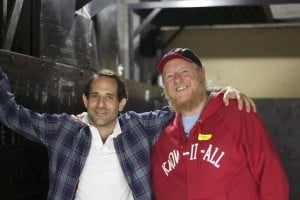
I am a big believer in experiments and breaking new ground. There have been any number of attempts to accomplish Fair Trade and anti-sweatshop goals, including the failed experiment that was sweatX. I would argue most are really just pilot studies. Extrapolation from a pilot study to large scale strategy cannot be assumed to be possible, partly due to the exceptional resources and favorable conditions that often accompany a pilot study. American Apparel is no five person sewing collective, twenty people that started with some sort of grant, or some rich guy trying an experiment with his dough. American Apparel has thousands of employees. That’s right, thousands. There are about 7000 world-wide and 5000 in LA alone. There are over 2700 people that are employed just doing the work of sewing, all right in Downtown LA.
The factory is seven stories of mostly manufacturing, plus a building in back and four more buildings in the area.
So we got a show tour right? Wrong. I haven’t set foot inside American Apparel in three or four years. Ten minutes before the end of the Long Beach Imprinted Sportswear Show I ran into Dov, who had just arrived. I told him about the Ink Kitchen and he invited us to tour the factory the next day. Here are Dov inviting me and Marty telling me we can have the “twenty-five cent tour, that’s the big one.”
We went the next morning and there obviously was no time for them to plan for our visit and we received a tour that was at least five times what a nickel tour would be. We were given full access to every portion of the building. We asked: Can we go on one more floor? Yes. Can we go to the building in the back? Yes. Can we go back to the fourth floor and take photos? Yes. Can we go to the other buildings now? Sure. Can we now see second shift? Yes. We had unqualified unlimited access granted to us and we were allowed to see everything, talk to anyone, and take photos of everything. The only thing that could be called a restriction was that we were asked not to use a few photos that revealed proprietary processes.
What we saw was a beehive of activity. The place is well lit, well ventilated, safe, and I didn’t see anyone yelling at anyone or even standing over anyone. I saw thousands (literally) of people that clearly knew what they had to do and they were freakin’ doing it. Shirts, hoodies, bikini tops, shoes,….31,000 SKUs being cranked out. The workers are in teams and they are paid for what they produce and on some teams workers were making over $20 per hour. I couldn’t do the math while walking around but the wages are posted per hour on boards near each sewing team and it looked like most workers were making an average of around just under $10 an hour. I saw areas where they give the workers free massages during their breaks. Sewing is hard, hard work and the massages sure looked appreciated.
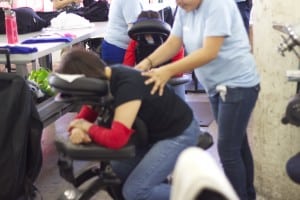
There is a medical clinic in a prominent place in the factory and American Apparel spent $9 million on medical care for employees last year. On the whole, folks working in the apparel industry do not receive any kind of medical assistance from their employers. Anecdotally I know print shops rarely have good medical insurance coverage and neither do garment manufacturing plants. I tried to get some data online about medical coverage in the apparel business and pretty much nothing comes up. I don’t think there is much going on in the world for health care for sewing workers.
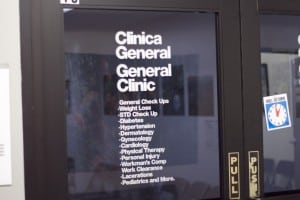
Upward mobility is possible at American Apparel. Jeremias Pablo is an immigrant from Guatemala who started at the bottom. He has risen in the ranks and is the Sewing Production Manager, supervising over 3000 workers. I talked with this soft spoken man who is not only an example for others in the company who want to move up the ranks, and but is also a person that clearly understands the folks he supervises because he was one of them.
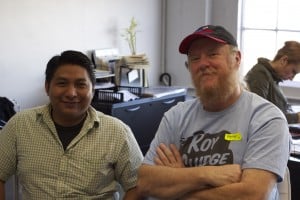
I have to say that I don’t really understand why there are so many attacks on American Apparel, particularly by the anti-sweatshop movement. Maybe it is the Mark Twain adage, “Few things are harder to put up with than the annoyance of a good example.” I know I have been in unionized plants that are nowhere near the standards I see at American Apparel. I know also that this place if far from perfect. However, they are making the loudest and in some ways the best effort to change the garment industry away from its exploitive ways. And perfection is the enemy of good.
[divider type=”black|thin|thick|short|dotted|dashed” spacing=”10″]
American Apparel
January 21,2014
I dropped by for a visit at the American Apparel factory in downtown LA today and was shown every aspect of production. Nothing was off limits. American Apparel is the real deal–a large-scale production facility making goods in the USA and treating their workers fairly. I’ll show you more later.
–Rick

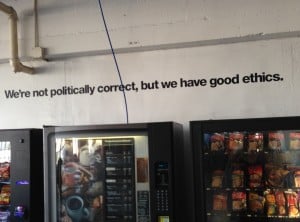


It is sad to see someone with such a great vision of producing American made garments and employing fair wages to be booted from the very company they worked hard to create. Hopefully this is not the last we will be hearing on this matter, as there are always two sides to every story.